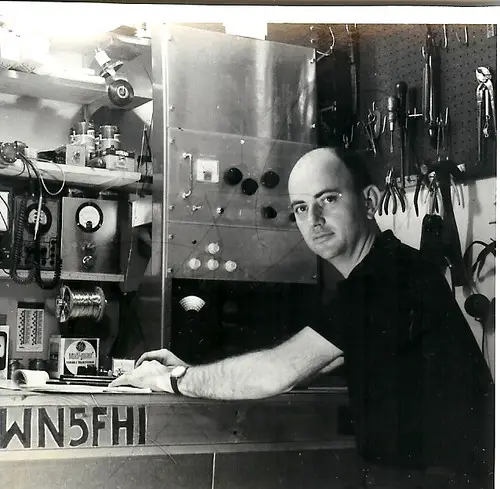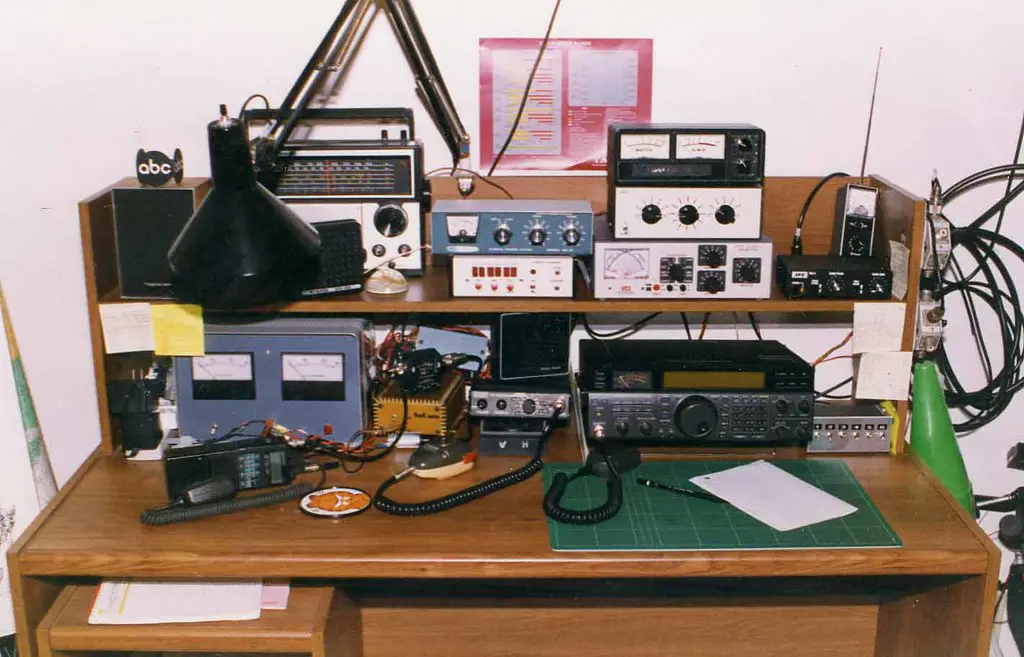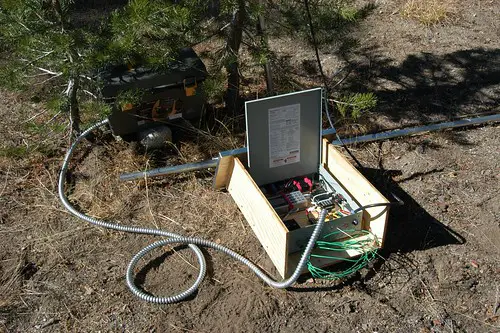- Ham radio (aka amateur radio) is an excellent and exciting hobby. It lets individuals communicate wirelessly with others, no matter where they are or if other networks are available.
- With ham radio, you can talk to other operators worldwide. Chats can be about anything from casual topics to emergencies. It is fun and creates a sense of community between like-minded people who love tech and communication- check out my ham radio beginner guide to get started!
- Unlike other forms of communication, ham radios don’t need any outside infrastructure. In times of disaster, or when other networks are down or busy, ham radios can still send messages. This independence can be lifesaving when info needs to be shared quickly.
- Plus, ham radio operators can use different frequency bands for various functions: voice, data, satellite relays, and intercontinental communication. There are many possibilities to explore and experiment in this field- check out some of my favourite ham radio brands!
If you’re into tech and connecting with others, ham radio could be perfect. Get your license and join a community that combines tech, outreach, and friendship through radio waves!
What is a Ham Radio?
A ham radio, or amateur radio, is a device licensed operators use to communicate worldwide. It lets people connect with hobbyists and share messages, experiences, and emergency info. Ham radios are known for their versatility and ability to work when other communication methods fail.
These radios allow individuals to explore wireless communication and build technical skills. They offer many communication options, such as voice transmission, data transfer, satellite communications, and digital modes like Morse code. With their unique capabilities, ham radios are invaluable for disaster management and remote areas where traditional communication might be lacking.
What’s cool about ham radios is that they can be used anywhere, not just in formal networks. Wireless operators can connect with anyone, creating a global community among fans, regardless of their borders or cultures.
To take advantage of ham radio, we suggest:
- Participate in Amateur Radio Contests: These help operators show their skills and compete with people worldwide. You can learn from experts and improve your abilities.
- Join Amateur Radio Clubs: Joining clubs allows you to connect with similar people with guidance and new perspectives on using ham radios.
- Engage in Emergency Communications Training: Learning emergency communication protocols ensures you’re ready to help when communication is essential during challenging situations.
- Explore Different Operating Modes: Playing with different operating modes broadens your understanding of ham radio capabilities and helps you adapt to different communication scenarios.
Each suggestion works because they open up chances to learn and grow within the amateur radio community. Contests foster competition and help you use your equipment better.
Clubs are places to swap ideas, network, and learn from experienced operators. Emergency communications training gives you the skills to help out when needed. Exploring different operating modes boosts versatility and adaptability so you can perform well in any communication situation.
History of Ham Radio
Ham radio had its roots in the late 19th century when amateur experimenters explored wireless communication. This hobby became popular when licenses were granted, and clubs were formed.
These early radio fans communicated during disaster or war when other methods had failed. WWII technology extended the reach of ham radio operators further.
The Amateur Radio Relay League (ARRL) was founded in 1914. It was a hub for ham radio lovers. The ARRL offered resources and support and worked to protect and advocate for amateur radio frequencies.
Pro Tip: To master this great hobby, join local ham radio clubs and participate in contests.
Uses of Ham Radio
Ham Radio, also known as Amateur Radio, is used for many purposes. It allows people to communicate over long distances during emergencies or when other communication systems don’t work. Plus, it helps with advancing science and technology. It also promotes international friendship, understanding, and cultural exchange by connecting people from different cultures.
These are some of its uses:
- Emergency communication – Communication during disasters such as earthquakes or hurricanes is critical.
- Exploring Science – Amateur radio users help with scientific research by tracking weather or monitoring radio waves.
- Community Service – They help with public service events such as marathons or parades by giving communication support.
- Cultural Exchange – Amateur radio allows people from different countries to talk, breaking down barriers.
This radio type also has features that can’t be found in commercial systems. Digital modes enable text messaging and data transfer even when voice transmission isn’t possible. Specialized equipment allows users to send signals off satellites or the moon!
To get the best out of ham radio:
- Join local amateur radio clubs.
- Attend workshops or training sessions to learn more.
- Upgrade equipment for new technology.
- Take part in contests or awards programs to show your skills.
By following these tips, you’ll make the most of ham radio and its multiple uses. From helping with emergency response to discovering science, ham radio is an excellent tool for communication lovers worldwide.
Getting Started with Ham Radio
Are you drawn to the world of ham radio? Tech-savvy or just curious? Here’s what you need to consider.
- First, acquire a license. This ensures operators uphold rules and regulations, promoting safe and responsible communication.
- Next, pick the right equipment. From handheld transceivers to base stations, there’s something for everyone.
- Then, join a community. Local clubs, events, and online forums can help you learn and make friends.
- Remember, your journey may take different paths. Discover your niche, explore frequencies, and make unexpected connections.
- Don’t miss out on the endless possibilities this hobby holds. Get your license, select the best gear, and join vibrant communities. Unleash your curiosity through amateur radio – the time is now!
Understanding Ham Radio Operations
The universe of Ham Radio Operations is enthralling and offers an extraordinary communication method. Let’s jump into this captivating subject and investigate its internal elements.
Wavelength Range | Frequency
- Very Low Frequency | 3 kHz – 30 kHz
- Low Frequency | 30 kHz – 300 kHz
Ham radio works inside explicit wavelength reaches that compare with different recurrence groups. For instance, the exceptionally low-frequency band reaches out from 3 kHz to 30 kHz, while the low-frequency band covers the scope from 30 kHz to 300 kHz. By understanding these frequency groups and their related wavelengths, ham radio administrators can choose the most appropriate range for their correspondence needs.
Besides wavelength reaches, it is critical to note that ham radio activities require a permit. The permitting cycle guarantees that administrators have the vital information and abilities to work their radios dependably.
This guarantees productive utilization of accessible frequencies and adherence to ham radio operations guidelines.
To upgrade your ham radio experience, think about these proposals:
- Join a nearby ham radio club: Interfacing with other devotees permits you to trade thoughts, take an interest in gathering exercises, and pick up valuable bits of knowledge from experienced administrators.
- Typically refresh your gear: Innovation advances quickly, and remaining side by side with the most recent advancements in radios and receiving wires can significantly improve your correspondence capacities.
- Continuously grow your insight: Ham radio is a ceaselessly advancing field, with consistently new strategies, modes, and advancements to find. Engage in ongoing learning through books, online assets, or attending workshops/webcasts.
- Take part in contests or events: These events provide opportunities to test your skills against other operators worldwide while promoting community fellowship.
By following these suggestions, you can maximize your ham radio experience and become essential to this vibrant communication community. Stay curious, keep exploring, and enjoy the wonders of ham radio operations.
Basic Ham Radio Terminology
Ham radio requires the use of specific terminology to communicate effectively. Frequency bands, call signs, Q signals, and the RST system are all essential to the process.
Frequencies are critical – they tell operators where to communicate. Call signs to identify who’s speaking. Q signals are shorthand codes for quick messages. The RST system is used to report signal quality.
To get the most out of these terms:
- Use Q signals in conversations.
- Have a list of Q signals handy.
- Learn the different frequency bands.
- Watch experienced operators and learn the RST system.
These suggestions allow ham radio enthusiasts to become pros at using basic terminology. That way, communication within the community will be smoother, and operators can share experiences across the globe.
Advancing in Ham Radio
Expand your knowledge. Get higher licenses, take a ham radio test, and unlock new privileges and frequencies.
Communicate with more operators.
Experiment with antennas and equipment. Make small changes for significant impacts on signal strength and quality.
Take part in contests and events that challenge your operating skills. Compete with other ham radio operators and sharpen your abilities.
Join local or online ham radio clubs. Get valuable support, mentorship, and collaborative projects.
Explore different modes of communication. Learn digital methods like PSK31 or DMR. Broaden your horizons and open new experiences.
Stay updated with advancements. Knowledge helps you stay ahead and adapt to changes.
Tip: Experiment with building or modifying equipment. Personalize it according to needs.
Ham radio has come a long way. The first recorded amateur wireless transmission was in 1898! It’s a vital emergency communication tool and a fascinating hobby connecting people worldwide.
Troubleshooting Common Issues
Got issues with your ham radio? Here are common ones and how to fix them:
- No power? Check if the cable is connected firmly and the power is working.
- Weak signal? Make sure the antenna is attached correctly and in a good spot.
- Interference? Find nearby electronic devices that may be causing it and move away from them.
- Audio problems? Adjust the volume & check if the mic is working.
- Frequency drift? Calibrate the frequency settings to keep the signal stable.
- Programming errors? Double-check the scenes and see if they match the desired frequencies.
Clean the equipment too. Dirt & debris can mess with performance. Maintenance helps avoid issues.
Pro Tip: Update the radio’s firmware. Bug fixes, improved features, better performance. Software updates can solve compatibility issues & unexpected glitches.
Conclusion
The ham radio, an amateur radio, is a powerful communication tool. It enables users to connect with fellow enthusiasts across the globe. Its flexible frequencies and modes provide countless possibilities for exploration and collaboration.
Some key points to consider are:
- Ham radios may be vital during disasters or emergencies when standard communication systems aren’t available. This is true in remote areas or when infrastructure is damaged.
- Amateur radio operators can experiment with different technologies and techniques. They can construct equipment and antennas, explore new transmission modes, and participate in satellite communications and competitions.
- This radio also brings a sense of community among users. Through local clubs, online forums, and international events like field days, hams can exchange knowledge, experiences, and companionship.
Remember that ham radios are regulated by governing bodies to make sure they’re used responsibly and with minimal disruption to other services. All users need to comply with licensing procedures and operating guidelines.
To make the most out of the ham radio experience:
- Get involved in your local amateur radio club or organization. You’ll get resources, assistance, and the chance to learn from experienced operators.
- Participate in contests or special events within the amateur radio community. Not only will it be an enjoyable challenge, but it will also let you link with fellow enthusiasts globally.
- Buy quality equipment that fits your interests and needs. Whether you prefer portable operations or stationary setups at home, having reliable gear ensures a smooth communication experience.
By following these steps, you can fully appreciate the world of amateur radio and unlock limitless possibilities for exploration, connection, and personal growth within this exciting hobby.
Frequently Asked Questions
What is ham radio?
A ham radio, also known as amateur radio, is a two-way communication technology that allows individuals to explore, experiment, and engage with various radio communications. It enables licensed operators to communicate with other ham radio operators worldwide.
What are the benefits of using ham radio?
Using a ham radio offers several benefits, including:
- Emergency communication: During natural disasters or emergencies, ham radios can be a reliable form of communication when other means, such as phones or internet services, are unavailable.
- Hobby and experimentation: Ham radio enthusiasts enjoy experimenting with radio equipment, exploring different communication techniques, and building connections with fellow operators.
- Learning opportunity: Operating a ham radio is a chance to learn about electronics, radio wave propagation, antennas, and other technical aspects of radio communication.
- Community involvement: The ham radio community offers a chance to connect with like-minded individuals, participate in events, and engage in public service activities.
Who can operate a ham radio?
Anyone can become a licensed ham operator by passing a qualifying exam. The licensing process ensures that operators understand radio regulations, operating procedures, and technical concepts.
What are the different license classes for ham radio operators?
The FCC (Federal Communications Commission) issues three different classes of amateur radio licenses in the United States: Technician, General, and Amateur Extra. Each class offers specific operating privileges, with Amateur Extra being the highest.
Do ham radio operators need to renew their licenses?
Yes, amateur radio licenses need to be renewed periodically. In the United States, ham radio licenses are issued for ten years. Operators can renew their claims 90 days before the expiration date, ensuring they continue operating legally.
Can ham radios communicate with other types of radios?
Ham radios can communicate with various radios, including other ham radios, citizens band (CB) radios, and some business radios, provided the frequencies and modes are compatible. However, it is essential to understand and comply with any regulations regarding frequency usage and licensing requirements to avoid legal issues.





